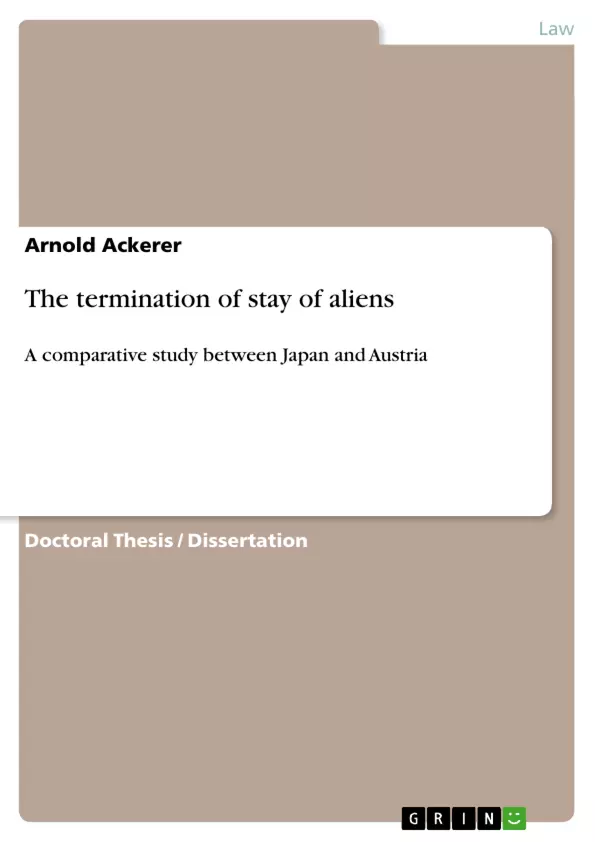In this thesis a comprehensive discussion of the current immigration and deportation systems of both Japan and Austria provides the basis for qualitative and quantitative comparisons.
The first section explains the basic methodology, the idea of comparative public law and respective international regimes that influence the alien law in either or both countries.
In the second part the immigration system of both Austria and Japan are explained in considerable detail (introducing only high-profile case law, though) including new legislation introduced in most recent years. The system of residence titles in both countries is discussed with reference to particular group of immigrants such as family members of already residing foreign nationals, work related immigration, short-term and long-term visitors. An overview of the respective organization of the immigration control administration is provided before the last chapter of part two compares the immigration laws of both countries. The quantitative comparison employs, extends and adjusts the Quantitative Index for the Integration of Immigrants by H. Waldrauch (associated also with the work of Prof. U. Davey).
Part three is extensively discusses the system of "termination of stay" in both countries. This also includes the newly introduced (2004) revocation of residence titles (zairyū shikaku no torikeshi) and the departure order (shukkoku meirei) on the Japanese side and the new system of residence bans (Aufenthaltsverbote) etc. on the Austrian side (2005). This part also features (1) detailed case law on both systems (for Japan particularly in regard to the special residence permit), (2) a short explanation of detention facilities and detention related problems, (3) a discussion of problems inherent to each system and ends with a (4) qualitative and (5) quantitative analysis similar to the one provided for the immigration systems.
Inhaltsverzeichnis (Table of Contents)
- INTRODUCTION
- PART ONE:
- METHODOLOGY AND BACKGROUND
- 1. METHODOLOGICAL AND HISTORICAL ISSUES
- 1.1. METHODOLOGY
- 1.2. SOCIO-HISTORICAL BACKGROUND
- 1.3. IMMIGRATION, CITIZENSHIP AND STATE-SOVEREIGNTY
- 2. INTERNATIONAL REGIMES
- PART TWO:
- THE IMMIGRATION SYSTEMS OF JAPAN AND AUSTRIA
- 3. THE JAPANESE IMMIGRATION SYSTEM
- 4. THE AUSTRIAN IMMIGRATION SYSTEM
- 5. THE JAPANESE AND AUSTRIAN IMMIGRATION SYSTEMS - COMPARISON AND
- INTERPRETATION
- PART THREE:
- THE DEPORTATION SYSTEMS OF JAPAN AND AUSTRIA
- 6. THE TERMINATION OF STAY
- 7. THE TERMINATION OF STAY IN THE JAPANESE IMMIGRATION CONTROL SYSTEM
Zielsetzung und Themenschwerpunkte (Objectives and Key Themes)
This work aims to provide a comparative study of the termination of stay of aliens in Japan and Austria. It analyzes the legal frameworks, administrative procedures, and practical considerations surrounding the termination of stay for non-nationals in both countries. The study uses a functional approach and examines legal cultures and socio-historical backgrounds to provide a comprehensive understanding of the subject.
- Comparative analysis of legal frameworks for termination of stay in Japan and Austria
- Examination of the socio-historical background and legal cultures of both countries
- Exploration of international legal regimes relevant to the subject
- Analysis of administrative decision-making processes in both countries
- Comparison of quantitative measures of immigration control in Japan and Austria
Zusammenfassung der Kapitel (Chapter Summaries)
- Chapter 1: This chapter introduces the methodology and socio-historical background of the study. It discusses the functional approach, legal families, legal cultures, and the role of comparative law in the research. It also provides an overview of the socio-historical context of immigration in Japan and Austria.
- Chapter 2: This chapter examines the international legal framework relevant to the termination of stay, including the International Covenant on Civil and Political Rights, the Convention on the Rights of the Child, and the Schengen system. It discusses the European Convention on Human Rights and its compliance mechanism.
- Chapter 3: This chapter provides a comprehensive overview of the Japanese immigration system, including legal sources, basic concepts, entry requirements, residence titles, and the organizational framework. It examines various aspects of the system, such as landing, visa, and residence title procedures.
- Chapter 4: This chapter focuses on the Austrian immigration system, examining its legal sources, basic remarks, entry system, residence titles, and organizational framework. It analyzes the requirements for obtaining residence and settlement permits, including the Integration Agreement.
- Chapter 5: This chapter presents a qualitative and quantitative comparison of the Japanese and Austrian immigration systems. It analyzes administrative decision-making, visa systems, denial of entry, preferential treatment, skilled and unskilled labor, temporary and long-term residence, and organizational differences.
Schlüsselwörter (Keywords)
The primary keywords and focus topics of this text include termination of stay, alien, immigration, deportation, comparative law, Japan, Austria, legal culture, socio-historical background, international regimes, administrative decision-making, quantitative immigration control, and legal frameworks.
- Arbeit zitieren
- Arnold Ackerer (Autor:in), 2006, The termination of stay of aliens, München, GRIN Verlag, https://www.hausarbeiten.de/document/78677


